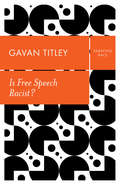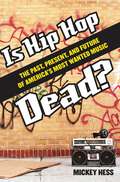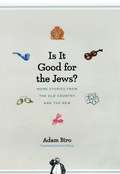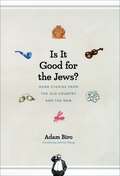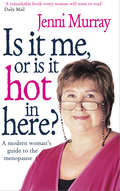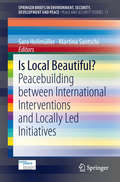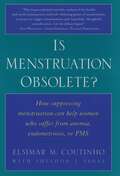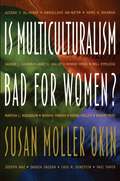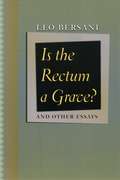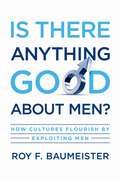- Table View
- List View
Is China Unstable?: Assessing the Factors
by David L. ShambaughFocuses on the potential for instability in China from political, economic, and historical perspectives. The book considers elite (national) and local politics, micro- and macro-economics, urban and rural conditions, attitudes among intellectuals, and minority areas. The high profile contributors include Thomas Bernstein, Pieter Bottelier, Bruce Dickson, June Dryer, Merle Goldman, Steven Jackson, Nicholas Lardy, H. Lyman Miller, David Shambaugh, and Dorothy Solinger.
Is China Unstable?: Assessing the Factors (Studies On Contemporary China)
by David L. ShambaughFocuses on the potential for instability in China from political, economic, and historical perspectives. The book considers elite (national) and local politics, micro- and macro-economics, urban and rural conditions, attitudes among intellectuals, and minority areas. The high profile contributors include Thomas Bernstein, Pieter Bottelier, Bruce Dickson, June Dryer, Merle Goldman, Steven Jackson, Nicholas Lardy, H. Lyman Miller, David Shambaugh, and Dorothy Solinger.
Is Fashion a Woman's Right?
by Carolyn BeckinghamThis book addresses the evidence for the widespread belief that enjoyment of fashion is necessarily inconsistent with feminist values, from a feminist (as opposed to a post-feminist) point of view. It begins by establishing that many feminists in fact hold this belief and argues that disagreeing does not mean claiming that feminism was unnecessary or that it is now rendered redundant by changing social mores. The author describes the historical background as applied to both men's and women's clothing in various cultures, including close reading of the function of clothes in the novels of the Bronte sisters, Thackeray and Dickens, through to the use of fashion as a call to arms for the early feminists, as well as later theorists like Susan Sontag and Naomi Wolf. Issues of personal freedom and political correctness, the claims that fashion makes women sex objects for men, and the charge that the subject is too trivial to merit serious discussion, are all challenged. Allegations of links between fashion and pornography are explored, and the disagreements between feminists on this topic set out. Finally, the issue of dressing for special occasions and whether this practice has a place in the modern world is addressed with candour. Is Fashion a Woman's Right? re-establishes the relationship between fashion and feminist values.
Is Free Speech Racist? (Debating Race)
by Gavan TitleyThe question of free speech is never far from the headlines and frequently declared to be in crisis. Starting from the observation that such debates so often focus on what can and cannot be said in relation to race, Gavan Titley asks why racism has become so central to intense disputes about the status and remit of freedom of speech. Is Free Speech Racist? moves away from recurring debates about the limits of speech to instead examine how the principle of free speech is marshalled in today’s multicultural and intensively mediated societies. This involves tracing the ways in which free speech has been mobilized in far-right politics, in the recycling of ‘race realism’ and other discredited forms of knowledge, and in the politics of immigration and integration. Where there is intense political contestation and public confusion as to what constitutes racism and who gets to define it, ‘free speech’ has been adopted as a primary mechanism for amplifying and re-animating racist ideas and racializing claims. As such, contemporary free speech discourse reveals much about the ongoing life of race and racism in contemporary society.
Is Hip Hop Dead?: The Past, Present, and Future of America's Most Wanted Music
by Mickey HessHip hop is remarkably self-critical as a genre. In lyrics, rappers continue to debate the definition of hip hop and question where the line between underground artist and mainstream crossover is drawn, who owns the culture and who runs the industry, and most importantly, how to remain true to the culture's roots while also seeking fame and fortune. The tension between the desires to preserve hip hop's original culture and to create commercially successful music promotes a lyrical war of words between mainstream and underground artists that keeps hip hop very much alive today. In response to criticisms that hip hop has suffered or died in its transition to the mainstream, this book seeks to highlight and examine the ongoing dialogue among rap artists whose work describes their own careers.Proclamations of hip hop's death have flooded the airwaves. The issue may have reached its boiling point in Nas's 2006 album Hip Hop is Dead. Nas's album is driven by nostalgia for a mythically pure moment in hip hop's history, when the music was motivated by artistic passion, instead of base commercialism. In the course of this same album, however, Nas himself brags about making money for his particular record label. These and similar contradictions are emblematic of the complex forces underlying the dialogue that keeps hip hop a vital element of our culture. Is Hip Hop Dead? seeks to illuminate the origins of hip hop nostalgia and examine how artists maintain control of their music and culture in the face of corporate record companies, government censorship, and the standardization of the rap image.Many hip hop artists, both mainstream and underground, use their lyrics to engage in a complex dialogue about rhyme skills versus record sales, and commercialism versus culture. This ongoing dialogue invigorates hip hop and provides a common ground upon which we can reconsider many of the developments in the industry over the past 20 years. Building from black traditions that value knowledge gained from personal experience, rappers emphasize the importance of street knowledge and its role in forging a career in the music business. Lyrics adopt models of the self-made man narrative, yet reject the trajectories of white Americans like Benjamin Franklin who espoused values of prudence, diligence, and delayed gratification. Hip hop's narratives instead promote a more immediately viable gratification through crime and extend this criminal mentality to their work in the music business. Through the lens of hip hop, and the threats to hip hop culture, author Mickey Hess is able to confront a range of important issues, including race, class, criminality, authenticity, the media, and personal identity.
Is It Ever Just Sex?
by Darian Leader‘Insanely readable! I loved it’ Slavoj ŽižekA delightfully thought-provoking study of why we have sex, from award-winning psychoanalyst Darian Leader‘It was just sex…’It’s a familiar claim. But it’s also an impossibility, as Darian Leader shows in this delightfully thought-provoking study.Our bodies aren’t just sticks that make fire when you rub them together, and our minds don’t simply stand by – as we can see from the pain, heartache and regret that so often accompany the highs of sexual excitement.As acclaimed psychoanalyst Darian Leader argues, with his trademark clarity, energy and wit, sex is always about so much more than itself – it’s about phantasy, anxiety, guilt, revenge, violence, love. Drawing on his long analytic experience, historical research and case studies to explore their importance to every aspect of our sexual lives, Leader brilliantly reveals what we are really thinking about when we think about sex – and what we are really doing when we do it.'A thoroughly engaging and ever-illuminating read' iNews'One of our most important contemporary thinkers' Guardian'Leader is as much a philosopher as a psychoanalyst and his ideas are engrossing and enlightening' Metro
Is It Good for the Jews?: More Stories from the Old Country and the New
by Adam Biro“Jewish stories,” writes Adam Biro, “resemble every people’s stories.” Yet at the same time there is no better way to understand the soul, history, millennial suffering, or, crucially, the joys of the Jewish people than through such tales—“There’s nothing,” writes Biro, “more revelatory of the Jewish being.” With Is It Good for the Jews? Biro offers a sequel to his acclaimed collection of stories Two Jews on a Train. Through twenty-nine tales—some new, some old, but all finely wrought and rich in humor—Biro spins stories of characters coping with the vicissitudes and reverses of daily life, while simultaneously painting a poignant portrait of a world of unassimilated Jewish life that has largely been lost to the years. From rabbis competing to see who is the most humble, to the father who uses suicide threats to pressure his children into visiting, to three men berated by the Almighty himself for playing poker, Biro populates his stories with memorable characters and absurd—yet familiar—situations, all related with a dry wit and spry prose style redolent of the long tradition of Jewish storytelling. A collection simultaneously of foibles and fables, adversity and affection, Is It Good for the Jews? reminds us that if in the beginning was the word, then we can surely be forgiven for expecting a punch line to follow one of these days.
Is It Good for the Jews?: More Stories from the Old Country and the New
by Adam Biro“Jewish stories,” writes Adam Biro, “resemble every people’s stories.” Yet at the same time there is no better way to understand the soul, history, millennial suffering, or, crucially, the joys of the Jewish people than through such tales—“There’s nothing,” writes Biro, “more revelatory of the Jewish being.” With Is It Good for the Jews? Biro offers a sequel to his acclaimed collection of stories Two Jews on a Train. Through twenty-nine tales—some new, some old, but all finely wrought and rich in humor—Biro spins stories of characters coping with the vicissitudes and reverses of daily life, while simultaneously painting a poignant portrait of a world of unassimilated Jewish life that has largely been lost to the years. From rabbis competing to see who is the most humble, to the father who uses suicide threats to pressure his children into visiting, to three men berated by the Almighty himself for playing poker, Biro populates his stories with memorable characters and absurd—yet familiar—situations, all related with a dry wit and spry prose style redolent of the long tradition of Jewish storytelling. A collection simultaneously of foibles and fables, adversity and affection, Is It Good for the Jews? reminds us that if in the beginning was the word, then we can surely be forgiven for expecting a punch line to follow one of these days.
Is It Me Or Is It Hot In Here?: A modern woman's guide to the menopause
by Jenni MurrayIn Is it me or it hot in here? Jenni Murray, one of Britain's most popular journalists and broadcasters, addresses the menopause. She looks at what the menopause is - its symptoms and how it affects overall health. She also looks at the psychological and social implications. There is an overview of the latest research on HRT - its benefits and drawbacks - and the new work which is being done on various 'alternative' therapies. She includes discussions on sex life, social life, face-lifts (or otherwise), exercise (or otherwise), keeping your figure and discovering one's place in life as a middle aged woman in a feminist era. The section on rethinking the menopause looks at changing attitudes and how to cope with post-menopausal life, offering a new agenda for post-menopausal women. Throughout, the tone is inquiring but accessible, making it one of the most appealing books on the menopause written to date.
Is It Tomorrow Yet?: Paradoxes of the Pandemic
by Ivan KrastevOne of our most scintillating public intellectuals explores the political paradoxes of the pandemic and helps us think our way through it'We are able to imagine anything because we are being besieged by something that was considered unimaginable...'Beneath the panic and bluster, beneath the confusing speeches and the conflicting advice, the Coronavirus pandemic acted, changing our world in the most profound ways. The tragic human cost and the economic devastation will be assessed and calculated for decades to come. But the pandemic also changed things in ways that are less easily expressed and understood. It has made bare the frayed contradictions of modern life. It has distorted things that seemed simple and settled. It has affirmed plain, uncomfortable truths. In this brilliant, thought-provoking essay, Ivan Krastev, one of our most interesting thinkers today, explores the pandemic's immediate consequences and conceives of its long-term legacy. Will things be different for the communities most harmed, and for those who escaped the worst? Where are we now with the US and China, with the UK and Europe? And how do we think our way through the unthinkable?
Is Local Beautiful?: Peacebuilding between International Interventions and Locally Led Initiatives (SpringerBriefs in Environment, Security, Development and Peace #11)
by Sara Hellmüller Martina SantschiBased on the swisspeace annual conference 2012, the publication examines the delicate balance between external interventions and locally-led initiatives. It addresses the question of what “local” means in the peacebuilding and development context; which actors on the ground actually represent the local level and how external actors choose their partners from amongst them. Moreover, it examines how local ownership - emerging as key criteria for any external intervention - is constituted: does this concept only imply local participation or is local control from the outset a must? Finally, it assesses the potential of locally-led initiatives and local conflict resolution mechanisms and their interaction with external interventions. Several authors provide insights on these questions and nuance our thinking about both local ownership and external interventions. As such, the publication aims to encourage critical reflections on this topical debate in peacebuilding and development.
Is Menstruation Obsolete?
by Elsimar M. Coutinho Sheldon J. SegalIs Menstruation Obsolete? argues that regular monthly bleeding is not the "natural" state of women, and that it actually places them at risk of several medical conditions of varying severity. The authors maintain that while menstruation may be culturally significant, it is not medically meaningful. Moreover, they propose that suppressing menstruation has remarkable health advantages. Because of cultural changes, shorter durations of breast feeding, and birth control, the reproductive patterns of modern women no longer resemble that of their Stone age ancestors. Women have moved from the age of incessant reproduction to the age of incessant menstruation. Consequently, they often suffer from clinical disorders related to menstruation: anemia, endometriosis, and PMS, just to name a few. The authors encourage readers to recognize what has gone previously unnoticed that this monthly discomfort is simply not obligatory. They present compelling evidence that the suppression of menstruation is a viable option for women today, and that it can be easily attained through the use of birth control pills. In fact, they reveal that contraceptive manufacturers, knowing that many women equate menstruation with femininity and that without monthly bleeding would fear that they were pregnant, engineered pill dosage regimens to ensure the continuation of their cycles. Indeed, throughout history societies have assigned menstruation powerful meaning, and Is Menstruation Obsolete? presents a fascinating history of how menstruation inspired doctors to try therapeutic bleeding for a variety of ailments, and how this therapy remained dominant in Western medicine until the early 20th century. Is Menstruation Obsolete? offers women a fresh view of menstruation, providing them with the information they need to make progressive choices about their health. This is a message whose time has come.
Is Multiculturalism Bad for Women?
by Susan Moller Okin Joshua Cohen Matthew Howard Martha C. NussbaumPolygamy, forced marriage, female genital mutilation, punishing women for being raped, differential access for men and women to health care and education, unequal rights of ownership, assembly, and political participation, unequal vulnerability to violence. These practices and conditions are standard in some parts of the world. Do demands for multiculturalism--and certain minority group rights in particular--make them more likely to continue and to spread to liberal democracies? Are there fundamental conflicts between our commitment to gender equity and our increasing desire to respect the customs of minority cultures or religions? In this book, the eminent feminist Susan Moller Okin and fifteen of the world's leading thinkers about feminism and multiculturalism explore these unsettling questions in a provocative, passionate, and illuminating debate. Okin opens by arguing that some group rights can, in fact, endanger women. She points, for example, to the French government's giving thousands of male immigrants special permission to bring multiple wives into the country, despite French laws against polygamy and the wives' own bitter opposition to the practice. Okin argues that if we agree that women should not be disadvantaged because of their sex, we should not accept group rights that permit oppressive practices on the grounds that they are fundamental to minority cultures whose existence may otherwise be threatened. In reply, some respondents reject Okin's position outright, contending that her views are rooted in a moral universalism that is blind to cultural difference. Others quarrel with Okin's focus on gender, or argue that we should be careful about which group rights we permit, but not reject the category of group rights altogether. Okin concludes with a rebuttal, clarifying, adjusting, and extending her original position. These incisive and accessible essays--expanded from their original publication in Boston Review and including four new contributions--are indispensable reading for anyone interested in one of the most contentious social and political issues today. The diverse contributors, in addition to Okin, are Azizah al-Hibri, Abdullahi An-Na'im, Homi Bhabha, Sander Gilman, Janet Halley, Bonnie Honig, Will Kymlicka, Martha Nussbaum, Bhikhu Parekh, Katha Pollitt, Robert Post, Joseph Raz, Saskia Sassen, Cass Sunstein, and Yael Tamir.
Is Multiculturalism Bad for Women?
by Susan Moller Okin Joshua Cohen Matthew Howard Martha C. NussbaumPolygamy, forced marriage, female genital mutilation, punishing women for being raped, differential access for men and women to health care and education, unequal rights of ownership, assembly, and political participation, unequal vulnerability to violence. These practices and conditions are standard in some parts of the world. Do demands for multiculturalism--and certain minority group rights in particular--make them more likely to continue and to spread to liberal democracies? Are there fundamental conflicts between our commitment to gender equity and our increasing desire to respect the customs of minority cultures or religions? In this book, the eminent feminist Susan Moller Okin and fifteen of the world's leading thinkers about feminism and multiculturalism explore these unsettling questions in a provocative, passionate, and illuminating debate. Okin opens by arguing that some group rights can, in fact, endanger women. She points, for example, to the French government's giving thousands of male immigrants special permission to bring multiple wives into the country, despite French laws against polygamy and the wives' own bitter opposition to the practice. Okin argues that if we agree that women should not be disadvantaged because of their sex, we should not accept group rights that permit oppressive practices on the grounds that they are fundamental to minority cultures whose existence may otherwise be threatened. In reply, some respondents reject Okin's position outright, contending that her views are rooted in a moral universalism that is blind to cultural difference. Others quarrel with Okin's focus on gender, or argue that we should be careful about which group rights we permit, but not reject the category of group rights altogether. Okin concludes with a rebuttal, clarifying, adjusting, and extending her original position. These incisive and accessible essays--expanded from their original publication in Boston Review and including four new contributions--are indispensable reading for anyone interested in one of the most contentious social and political issues today. The diverse contributors, in addition to Okin, are Azizah al-Hibri, Abdullahi An-Na'im, Homi Bhabha, Sander Gilman, Janet Halley, Bonnie Honig, Will Kymlicka, Martha Nussbaum, Bhikhu Parekh, Katha Pollitt, Robert Post, Joseph Raz, Saskia Sassen, Cass Sunstein, and Yael Tamir.
Is Racism an Environmental Threat? (Debating Race)
by Ghassan HageThe ecological crisis is the most overwhelming to have ever faced humanity and its consequences permeate every domain of life. This trenchant book examines its relation to Islamophobia as the dominant form of racism today, showing how both share roots in domination, colonialism, and the logics of capitalism. Ghassan Hage proposes that both racism and humanity’s destructive relationship with the environment emanate from the same mode of inhabiting the world: an occupying force imposes its own interest as law, subordinating others for the extraction of value, eradicating or exterminating what gets in the way. In connecting these two issues, Hage gives voice to the claim taking shape in many activist spaces that anti-racist and ecological struggles are intrinsically related. In both, the aim is to move beyond what makes us see otherness, whether human or nonhuman, as something that exists solely to be managed.
Is Satire Saving Our Nation?: Mockery and American Politics
by S. McClennen R. MaiselThe book studies the intersections between satirical comedy and national politics in order to show that one of the strongest supports for our democracy today comes from those of us who are seriously joking. This book shows how we got to this place and why satire may be the only way we can save our democracy and strengthen our nation.
Is Science Racist? (Debating Race)
by Jonathan MarksEvery arena of science has its own flash-point issues—chemistry and poison gas, physics and the atom bomb—and genetics has had a troubled history with race. As Jonathan Marks reveals, this dangerous relationship rumbles on to this day, still leaving plenty of leeway for a belief in the basic natural inequality of races.The eugenic science of the early twentieth century and the commodified genomic science of today are unified by the mistaken belief that human races are naturalistic categories. Yet their boundaries are founded neither in biology nor in genetics and, not being a formal scientific concept, race is largely not accessible to the scientist. As Marks argues, race can only be grasped through the humanities: historically, experientially, politically. This wise, witty essay explores the persistence and legacy of scientific racism, which misappropriates the authority of science and undermines it by converting it into a social weapon.
Is Technology Good for Education? (Digital Futures)
by Neil SelwynDigital technologies are a key feature of contemporary education. Schools, colleges and universities operate along high-tech lines, while alternate forms of online education have emerged to challenge the dominance of traditional institutions. According to many experts, the rapid digitization of education over the past ten years has undoubtedly been a ‘good thing’. Is Technology Good For Education? offers a critical counterpoint to this received wisdom, challenging some of the central ways in which digital technology is presumed to be positively affecting education. Instead Neil Selwyn considers what is being lost as digital technologies become ever more integral to education provision and engagement. Crucially, he questions the values, agendas and interests that stand to gain most from the rise of digital education. This concise, up-to-the-minute analysis concludes by considering alternate approaches that might be capable of rescuing and perhaps revitalizing the ideals of public education, while not denying the possibilities of digital technology altogether.
Is the Rectum a Grave?: and Other Essays
by Leo BersaniOver the course of a distinguished career, critic Leo Bersani has tackled a range of issues in his writing, and this collection gathers together some of his finest work. Beginning with one of the foundations of queer theory—his famous meditation on how sex leads to a shattering of the self, “Is the Rectum a Grave?”—this volume charts the inspired connections Bersani has made between sexuality, psychoanalysis, and aesthetics. Over the course of these essays, Bersani grapples with thinkers ranging from Plato to Descartes to Georg Simmel. Foucault and Freud recur as key figures, and although Foucault rejected psychoanalysis, Bersani contends that by considering his ideas alongside Freud’s, one gains a clearer understanding of human identity and how we relate to one another. For Bersani, art represents a crucial guide for conceiving new ways of connecting to the world, and so, in many of these essays, he stresses the importance of aesthetics, analyzing works by Genet, Caravaggio, Proust, Almodóvar, and Godard. Documenting over two decades in the life of one of the best minds working in the humanities today, Is the Rectum a Grave? and Other Essays is a unique opportunity to explore the fruitful career of a formidable intellect.
Is the Rectum a Grave?: and Other Essays
by Leo BersaniOver the course of a distinguished career, critic Leo Bersani has tackled a range of issues in his writing, and this collection gathers together some of his finest work. Beginning with one of the foundations of queer theory—his famous meditation on how sex leads to a shattering of the self, “Is the Rectum a Grave?”—this volume charts the inspired connections Bersani has made between sexuality, psychoanalysis, and aesthetics. Over the course of these essays, Bersani grapples with thinkers ranging from Plato to Descartes to Georg Simmel. Foucault and Freud recur as key figures, and although Foucault rejected psychoanalysis, Bersani contends that by considering his ideas alongside Freud’s, one gains a clearer understanding of human identity and how we relate to one another. For Bersani, art represents a crucial guide for conceiving new ways of connecting to the world, and so, in many of these essays, he stresses the importance of aesthetics, analyzing works by Genet, Caravaggio, Proust, Almodóvar, and Godard. Documenting over two decades in the life of one of the best minds working in the humanities today, Is the Rectum a Grave? and Other Essays is a unique opportunity to explore the fruitful career of a formidable intellect.
Is the Rectum a Grave?: and Other Essays
by Leo BersaniOver the course of a distinguished career, critic Leo Bersani has tackled a range of issues in his writing, and this collection gathers together some of his finest work. Beginning with one of the foundations of queer theory—his famous meditation on how sex leads to a shattering of the self, “Is the Rectum a Grave?”—this volume charts the inspired connections Bersani has made between sexuality, psychoanalysis, and aesthetics. Over the course of these essays, Bersani grapples with thinkers ranging from Plato to Descartes to Georg Simmel. Foucault and Freud recur as key figures, and although Foucault rejected psychoanalysis, Bersani contends that by considering his ideas alongside Freud’s, one gains a clearer understanding of human identity and how we relate to one another. For Bersani, art represents a crucial guide for conceiving new ways of connecting to the world, and so, in many of these essays, he stresses the importance of aesthetics, analyzing works by Genet, Caravaggio, Proust, Almodóvar, and Godard. Documenting over two decades in the life of one of the best minds working in the humanities today, Is the Rectum a Grave? and Other Essays is a unique opportunity to explore the fruitful career of a formidable intellect.
Is the Vicar in, Pet?: From the Pit to the Pulpit – My Childhood in a Geordie Vicarage
by Barbara FoxIn the heart of Ashington - a bustling Geordie mining town - a handsome red-brick vicarage, surrounded by rambling gardens, stands proudly among the rows of terraced houses. It is the perfect place for playing games, keeping secrets and chasing the ghosts of previous occupants, and it will be nine-year-old Barbara's new home now that her father is to be vicar in this strange new place. In this charming memoir, Barbara Fox recalls a childhood where parishioners knocked on the door at all hours of the day and night, and where no one batted an eye at the collection of waifs and strays who regularly joined the family at the kitchen table. This is a warm-hearted, classic tale of family, community and the unforgettable thrill of childhood adventure.
Is There Anything Good About Men?: How Cultures Flourish by Exploiting Men
by Roy F. BaumeisterHave men really been engaged in a centuries-old conspiracy to exploit and oppress women? Have the essential differences between men and women really been erased? Have men now become unnecessary? Are they good for anything at all? In Is There Anything Good About Men?, Roy Baumeister offers provocative answers to these and many other questions about the current state of manhood in America. Baumeister argues that relations between men and women are now and have always been more cooperative than antagonistic, that men and women are different in basic ways, and that successful cultures capitalize on these differences to outperform rival cultures. Amongst our ancestors---as with many other species--only the alpha males were able to reproduce, leading them to take more risks and to exhibit more aggressive and protective behaviors than women, whose evolutionary strategies required a different set of behaviors. Whereas women favor and excel at one-to-one intimate relationships, men compete with one another and build larger organizations and social networks from which culture grows. But cultures in turn exploit men by insisting that their role is to achieve and produce, to provide for others, and if necessary to sacrifice themselves. Baumeister shows that while men have greatly benefited from the culture they have created, they have also suffered because of it. Men may dominate the upper echelons of business and politics, but far more men than women die in work-related accidents, are incarcerated, or are killed in battle--facts nearly always left out of current gender debates. Engagingly written, brilliantly argued, and based on evidence from a wide range of disciplines, Is There Anything Good About Men? offers a new and far more balanced view of gender relations.
Is There Anything Good About Men?: How Cultures Flourish by Exploiting Men
by Roy F. BaumeisterHave men really been engaged in a centuries-old conspiracy to exploit and oppress women? Have the essential differences between men and women really been erased? Have men now become unnecessary? Are they good for anything at all? In Is There Anything Good About Men?, Roy Baumeister offers provocative answers to these and many other questions about the current state of manhood in America. Baumeister argues that relations between men and women are now and have always been more cooperative than antagonistic, that men and women are different in basic ways, and that successful cultures capitalize on these differences to outperform rival cultures. Amongst our ancestors---as with many other species--only the alpha males were able to reproduce, leading them to take more risks and to exhibit more aggressive and protective behaviors than women, whose evolutionary strategies required a different set of behaviors. Whereas women favor and excel at one-to-one intimate relationships, men compete with one another and build larger organizations and social networks from which culture grows. But cultures in turn exploit men by insisting that their role is to achieve and produce, to provide for others, and if necessary to sacrifice themselves. Baumeister shows that while men have greatly benefited from the culture they have created, they have also suffered because of it. Men may dominate the upper echelons of business and politics, but far more men than women die in work-related accidents, are incarcerated, or are killed in battle--facts nearly always left out of current gender debates. Engagingly written, brilliantly argued, and based on evidence from a wide range of disciplines, Is There Anything Good About Men? offers a new and far more balanced view of gender relations.
Is There Such a Thing as Populism?: 3 Provocations and 5 1/2 Proposals (Conceptualising Comparative Politics)
by Benjamin ArditiIs There Such a Thing as Populism? calls into question our common understanding of populism. Taken on their own, commonplace references to the people, leaders, or elites are more like dog whistles or false positives of populism than part of a serious attempt to address the phenomenon. Scholars asked themselves, “What is populism?” without realizing that this assumed there was such a thing and that we just needed to figure out what it meant. That was a mistake. Benjamin Arditi proposes that we put this certainty on hold and start from a different premise, asking, “Is there such a thing as populism?” This doesn’t rule out its existence or take it for granted.Structured as a set of polemical interventions and theoretical proposals, Arditi addresses key theoretical, methodological, and comparative questions in the study of populism. These include the limitations of formal definitions of populism, the importance of context and the conjuncture, polemics, the situated gaze, and issues concerning strategic relations and governing from below. Five subject experts, Nadia Urbinati, José Luis Villacañas, Carlos de la Torre, Anthoula Malkopoulou, and Anthony Spanakos, react to Arditi’s theses in captivating conversations on how to study populism and the way in which populism has been used in contemporary comparative analysis. Refreshingly different and thought-provoking, Is There Such a Thing as Populism? is the ideal departure for the exploration of this diverse and fascinating political movement.


